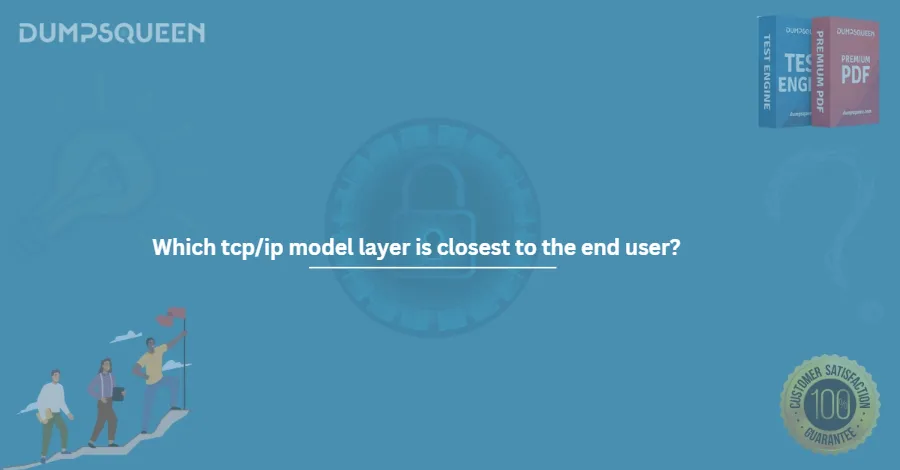Understanding the TCP/IP Model: A Guide for N10-008 Aspirants with DumpsQueen
Introduction
In the realm of computer networking, few models are as foundational as the TCP/IP Model. It serves as the bedrock for modern internet communication, offering a streamlined architecture that defines how data is packaged, transmitted, and received across interconnected systems. For aspiring network professionals preparing for the CompTIA Network+ N10-008 exam, understanding the TCP/IP model isn’t optional—it’s essential.
In this comprehensive guide, we’ll explore the layers of the TCP/IP model, identify the layer closest to the end user, break down the Application layer, and connect all of this with the real-world demands of the N10-008 exam. Along the way, we’ll also highlight how DumpsQueen, a trusted platform for exam preparation, can enhance your understanding, boost your confidence, and ultimately help you succeed in achieving certification.
Overview of the TCP/IP Model
The TCP/IP Model, also known as the DoD model (Department of Defense model), is a simplified, four-layered framework that enables communication across diverse types of hardware and software. Unlike the seven-layer OSI Model, the TCP/IP model is more practical and aligned with the internet’s actual architecture. It consists of:
- Application Layer
- Transport Layer
- Internet Layer
- Network Access Layer (sometimes known as the Link or Network Interface Layer)
Each of these layers has a specific role:
- The Application Layer supports application and end-user processes.
- The Transport Layer manages end-to-end communication and error checking.
- The Internet Layer handles addressing and routing through protocols like IP.
- The Network Access Layer deals with physical transmission of data on the local network.
Understanding how these layers interoperate is vital for network troubleshooting, design, and implementation—core areas tested on the N10-008 exam.
Identifying the Layer Closest to the End User
A frequent question on exams and in real-world networking contexts is: Which layer of the TCP/IP model is closest to the end user?
The answer is the Application Layer.
This layer is where user interaction occurs. Whenever someone opens a web browser, checks email, uses VoIP, or downloads a file, they are operating at the Application layer of the TCP/IP model. It encompasses high-level protocols and services that users interact with directly.
Examples of Application Layer Protocols:
- HTTP/HTTPS – for web browsing
- FTP – for file transfers
- SMTP/IMAP/POP3 – for email
- DNS – for resolving domain names
- Telnet/SSH – for remote management
The Application Layer doesn’t dictate how the data is displayed—that’s the job of software developers—but it ensures the protocols are in place so that communication between systems is possible.
From the perspective of the N10-008 exam, understanding the Application Layer's position and function helps answer scenario-based questions that assess your ability to diagnose and manage network services.
Details of the Application Layer
The Application Layer of the TCP/IP model plays a pivotal role in facilitating communication between users and network services. It encapsulates the functionality of the top three layers of the OSI model: Application, Presentation, and Session.
Key Responsibilities:
- Identifying communication partners: Determines the destination system for data exchange.
- Determining resource availability: Ensures both devices are ready to communicate.
- Synchronizing communication: Manages data integrity and flow control.
Common Protocols in Detail:
1. HTTP/HTTPS (Hypertext Transfer Protocol / Secure)
Used for web browsing. HTTPS adds encryption via SSL/TLS, ensuring secure communication.
2. DNS (Domain Name System)
Translates human-friendly domain names like www.google.com into IP addresses.
3. FTP/SFTP (File Transfer Protocol / Secure)
Used to upload or download files from a server. SFTP uses encryption for added security.
4. SMTP/POP3/IMAP (Email Protocols)
Used in sending and receiving email. SMTP handles sending, while POP3 and IMAP retrieve messages.
5. Telnet/SSH
Both are used for remote command-line access. SSH is preferred due to its encryption features.
All these protocols function at the Application Layer, supporting essential network services that modern businesses rely on.
Relevance to N10-008 Exam
The CompTIA Network+ N10-008 certification validates essential knowledge and skills required for IT networking professionals. A significant portion of the exam focuses on network architecture, protocols, and troubleshooting, all of which relate to the TCP/IP model and particularly the Application Layer.
Topics Directly Related to TCP/IP in N10-008:
- 1.3: Explain the concepts and characteristics of routing and switching.
- 1.4: Given a scenario, configure and deploy common Ethernet switching features.
- 2.1: Compare and contrast the Open Systems Interconnection (OSI) model layers and encapsulation concepts.
- 2.3: Explain the purposes and use cases for advanced networking devices.
- 3.2: Given a scenario, use the appropriate network software tools and commands.
- 4.1: Summarize the purposes of physical security devices.
- 5.2: Explain authentication and access controls.
When you study with DumpsQueen, you get access to updated, real-exam-style practice questions that are directly mapped to these N10-008 objectives. The platform ensures you don’t just memorize definitions but understand their application in real-world scenarios.
Practical Application
Let’s ground this knowledge with a practical scenario.
Scenario:
You’re working as a network technician at a mid-sized company. An employee reports that they can’t access a specific website, but they can ping the IP address successfully. What layer is most likely causing the issue?
Answer: Application Layer
Why? Since the employee can reach the IP address (meaning the lower layers like Internet and Network Access are functioning), the problem likely lies with DNS resolution—a service of the Application Layer.
Understanding such practical distinctions is crucial—not just to pass the N10-008 exam, but to excel in real-world troubleshooting. That’s where DumpsQueen shines.
By using DumpsQueen’s meticulously curated practice questions, you’ll come across scenarios just like this, helping you build a real-world mindset for problem-solving.
Why Choose DumpsQueen for Your N10-008 Preparation?
DumpsQueen is more than just another exam prep website—it’s a gateway to certification success. Here’s why it stands out, especially for those preparing for CompTIA Network+:
1) Real Exam Experience
The practice exams on DumpsQueen simulate the actual testing environment, complete with time limits, question formats, and difficulty levels. This helps reduce anxiety and boosts exam readiness.
2) Updated Questions
Unlike other platforms that rely on outdated material, DumpsQueen continually updates its question bank to align with the latest CompTIA objectives—including all the updates specific to the N10-008 version.
3) Detailed Explanations
It’s not just about knowing the correct answer; it’s about understanding why it's correct. DumpsQueen provides in-depth rationales for each question, helping you grasp core concepts like the TCP/IP model, protocols, and network layers.
4) Affordable and Accessible
DumpsQueen offers cost-effective bundles that make professional certification accessible to everyone, without compromising on quality.
5) Community and Support
Need help understanding a tricky question? DumpsQueen has a vibrant support system ready to assist you. You’re never studying alone.
Whether you're struggling to differentiate between layers of the TCP/IP model or need help mastering scenario-based questions, DumpsQueen is your ideal partner.
Conclusion
The TCP/IP model is the foundation upon which modern networking is built. Understanding its structure, especially the Application Layer, is crucial for anyone pursuing a career in networking or aiming to pass the CompTIA Network+ N10-008 exam. It’s the layer that interacts directly with users, supports critical protocols like HTTP, FTP, DNS, and SSH, and plays a central role in troubleshooting everyday networking issues.
But understanding these concepts isn’t enough—you also need to apply them under exam pressure. That’s where DumpsQueen comes in.
With up-to-date study materials, real-world scenarios, detailed answer explanations, and a user-friendly interface, DumpsQueen gives you the tools you need to ace your exam—and build a solid foundation for your networking career.
So if you're preparing for the N10-008 exam, don't just rely on textbooks and scattered notes. Trust DumpsQueen—the smart way to certify.
Free Sample Questions
Which TCP/IP model layer is closest to the end user?
A) Network Access Layer
B) Internet Layer
C) Transport Layer
D) Application Layer
Answer: D) Application Layer
In the TCP/IP model, which layer directly interacts with user applications like web browsers?
A) Internet Layer
B) Application Layer
C) Transport Layer
D) Network Access Layer
Answer: B) Application Layer
Which TCP/IP layer is responsible for providing services directly to end-user applications?
A) Transport Layer
B) Network Access Layer
C) Application Layer
D) Internet Layer
Answer: C) Application Layer
The layer in the TCP/IP model closest to the end user handles which of the following?
A) Data link control
B) IP addressing
C) User interface protocols like HTTP
D) Packet routing
Answer: C) User interface protocols like HTTP
Which TCP/IP model layer is most associated with end-user interactions, such as email or file transfers?
A) Network Access Layer
B) Internet Layer
C) Transport Layer
D) Application Layer
Answer: D) Application Layer




